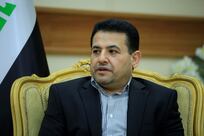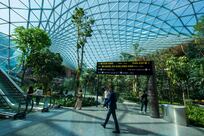In the 1960s, aerial photographs revealed Abu Dhabi as a sleepy fishing village far removed from what was, elsewhere, the era of satellites and skyscrapers. Now, decades later, Abu Dhabi has dramatically cast itself into the ranks of hard-charging global heavyweights. But how does a city grow into a metropolis, under the watchful eye of the world, without losing its essence?
Last week, New York University invited a number of lecturers to speak on Abu Dhabi's past, present and future. The motivation was clear - the lectures were being given at the brownstone serving as NYU Abu Dhabi's Manhattan home, and the mood was buoyantly optimistic, celebrating the marriage of a rapidly growing, wildly successful private university with a rapidly growing, wildly successful city.
There was even a touch of Abu Dhabi in the room; as Robert Hillenbrand delivered his lecture on the Sheikh Zayed Grand Mosque to a crowd of NYU Abu Dhabi brass, architecture grad students and undergrads considering a year abroad, attention was drawn to a stunning floral-patterned green carpet hung on the wall, which proved to be a scale version of the one gracing the mosque's floor.
Hillenbrand, succinctly summarising the design of the mosque, praised it as an "architectural benchmark by virtue of its scale, its ambition, and its reach". The mosque, in his view, is a fundamentally postmodern creation. Drawing on a "pan-Islamic" set of styles ranging from the Ottoman to that of Mughal India and Moorish Spain, the Sheikh Zayed Grand Mosque serves as a projection of how Abu Dhabi itself would prefer to be seen. A place for prayer that draws on traditions from across the Muslim world is meant to draw Muslims from all over the world.
Sitting far from Abu Dhabi's traditional downtown area, the mosque's peripheral wall and landscaping awaits completion - itself a potent symbol of a city in the midst of being built, if you choose to interpret it as one. But Hillenbrand sees that as proof of Abu Dhabi's promise, and an indication of the city's future. "It was prophetic of Sheikh Zayed to choose this site," he argued. "I absolutely promise you that in 30 years' time, the city will have engulfed it ... this will be an oasis."
The next night's speaker was like an extended footnote and explication of Hillenbrand's prophecy. Larry Beasley, former director of planning for Vancouver, spent the last five years in Abu Dhabi, working with the Urban Planning Council and crafting Plan 2030 for the city. This plan is a wide-ranging attempt to take the successful strategy for urban revitalisation known as "Vancouverism" and adapt it for the emirate, creating a more liveable city even as Abu Dhabi expands to anywhere between 2.5 and 3.5 million people in the decades to come.
Beasley spoke to the audience of about 50 people of the challenges and rewards of designing the future Abu Dhabi, arguing that its specifically Arab version of humane urbanism "may well be the preferred approach for really smart cities in the future".
Beasley, in a conversation after his lecture, was inclined to agree with Hillenbrand. "In the future, it'll be right in the centre," he said of the mosque, drawing a rough sketch of the future city on a scrap of paper. "Now, they built the mosque before we designed our new capital. I have a feeling that if we were doing it today, we would put the mosque right in the centre."
Vancouver reversed decades of urban decline beginning in the mid-1980s, more than doubling the population of its downtown by diversifying transit, reducing car traffic, and using public-private collaborations to increase the available pool of urban amenities - everything from new townhouses to public benches. "It just has to be - better to entice people away from the suburbs," Beasley argued in his talk, and Vancouver's remarkable success has been based in large part on its ability to make urban living attractive once again.
Who is a city for? Is it for its elite? Its workers? Its residents, or tourists? Abu Dhabi and Dubai present two contrasting models of urbanisation, and the example of Abu Dhabi was perpetually thrown into relief by Dubai's counter-example. Dubai, in Beasley's scheme, was a global city, inclined to sell itself to the world on the basis of its size and scope. Crucially, Dubai pushed land development to the forefront as the engine to turn the city into a global financial centre. Abu Dhabi, by contrast, is a postmodern city, one more devoted to improving the experience of living in the city for its residents.
Dubai, "in the vanguard of change" has made mistakes, according to Beasley, the same ones Abu Dhabi hopes to avoid.
"Dubai has just not had a plan," he says, "not had a coherent way to do things ... If you ask Abu Dhabians, they'll tell you they all go to Dubai to shop, but they couldn't live there."
But building a better city is not just a matter of avoiding the mistakes of other cities, or of replicating an already-developed model from elsewhere. "You can't just import things. That was the mistake of the generation before me of expats in places like Abu Dhabi or Dubai. They just took their ideas and brought them in. I mean literally, I've seen subdivisions."
Abu Dhabi's particular challenges - including the once chronic housing shortage - require previously untested solutions. Beasley was initially reluctant to work in a country so utterly unlike Canada, but saw an opportunity for rapid-fire improvement. "I did go with the advice of this fellow who said, if you can improve the circumstances, then it's worth you being there."
Plan 2030 establishes five particular goals for the new Abu Dhabi: to keep growth measured, to be sensitive to the natural environment, to serve as a capital city for the United Arab Emirates, to be a distinctively Arab city, and to ensure that Arab values, culture and mores will shape the city. Beirut and Marrakech served as the explicit models for Abu Dhabi, urban exemplars for a nation without an indigenous urban heritage.
Set to continue its rapid expansion in the coming years, Abu Dhabi poses a version of the fundamental problem facing urban planners in the 21st century: how to retain, or craft, the pleasures of urban living while extending them to millions of new city residents?
Everyone at last week's talks - lecturers, university officials, NYU students - was inclined to celebrate Abu Dhabi's emergence as an enlightened global hub, even as the new Abu Dhabi was still as much a matter of planning as reality.
Hillenbrand and Beasley were discussing Abu Dhabi's past and present in the reflected light of the city's proposed future - one where the fishing village of old has fully given way to the Middle Eastern megalopolis. Abu Dhabi presents one model for the 21st century city: carefully planned, distinctly Emirati, yet western in orientation and thoroughly Vancouverised.
For Beasley, the formula is entirely new and entirely familiar, all at once: "All of the specifics are different, but the underlying principles - mixed use, alternatives to the car, densification, active street life - all of those things, in principle, do apply. It's just that you have to do them in their way."





